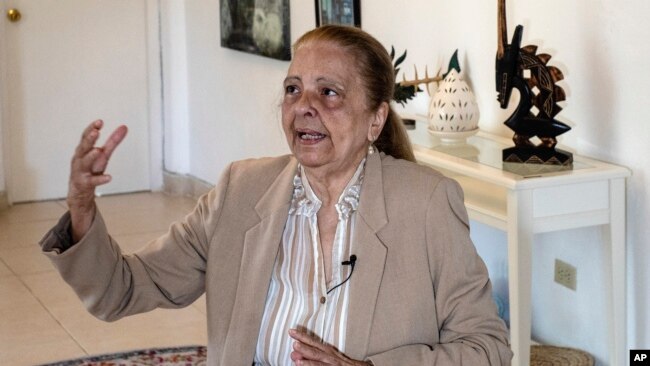제2차 세계대전 일본계 미국인 수감자들을 위한 엄숙한 기념비 125,000명 이상의 명단
Solemn Monument to Japanese American WWII Detainees Lists More Than 125,000 Names
페이지 정보
작성자 By Associated Press 작성일 24-02-18 07:26 댓글 0본문
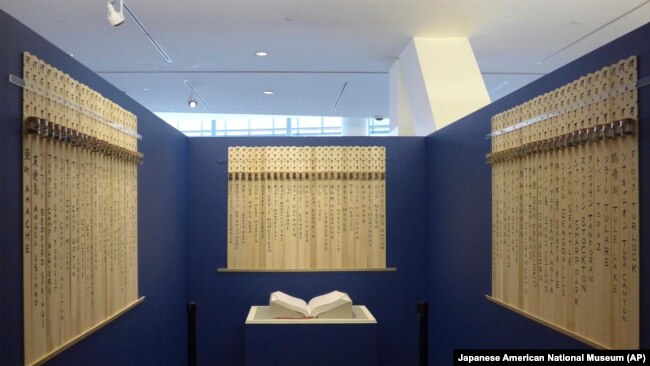
파일 - 제2차 세계대전 중 전국의 일본계 미국인 수용소에 억류되었던 125,000명 이상의 사람들의 이름을 나열한 책인 The Ireicho가 9월 로스앤젤레스의 박물관에서 전시됩니다
FILE - The Ireichō, a book which lists the names of the more than 125,000 people who were detained in internment camps for Japanese Americans nationwide during World War II, is seen at the museum in Los Angeles, Sept. 24, 2022.
로스앤젤레스 —
Los Angeles —
사만다 수미코 피네도와 그녀의 조부모님들은 일본계 미국인 국립 박물관의 희미하게 불이 켜진 울타리에 파일을 넣고, 이름 기둥들을 드러내기 위해 진열된 거대한 책에 다가갑니다. 피네도는 그 목록에 제2차 세계 대전 동안 일본계 미국인 수용소에 구금되었던 그녀의 증조부모님도 포함되기를 바라고 있습니다.
Samantha Sumiko Pinedo and her grandparents file into a dimly lit enclosure at the Japanese American National Museum and approach a massive book splayed open to reveal columns of names. Pinedo is hoping the list includes her great-grandparents, who were detained in Japanese American incarceration camps during World War II.
"많은 사람들에게, 제 2차 세계대전이었기 때문에 너무 오래 전처럼 느껴집니다. 그러나 저는 수용소에 있던 봄파(증조할아버지)와 함께 자랐습니다."라고 피네도는 말합니다.
“For a lot of people, it feels like so long ago because it was World War II. But I grew up with my Bompa (great-grandpa), who was in the internment camps,” Pinedo says.
로스앤젤레스에 있는 박물관의 한 문서가 부드럽게 (이레초라고 불리는) 책의 중앙으로 몸을 옮겨 한 페이지의 중앙 근처에 카네오 사카타니의 위치를 찾아냅니다. 이것은 피네도의 증조부였고, 그의 가족은 이제 그를 기릴 수 있습니다.
A docent at the museum in Los Angeles gently flips to the middle of the book — called the Ireichō — and locates Kaneo Sakatani near the center of a page. This was Pinedo’s great-grandfather, and his family can now honor him.
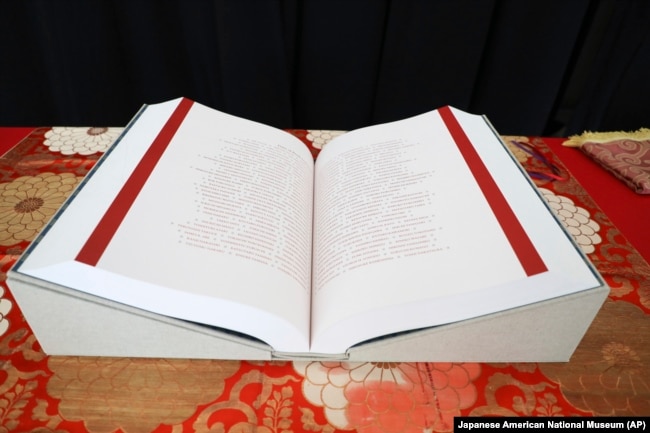
파일 - The Ireicho는 제2차 세계 대전 동안 전국적으로 일본계 미국인들을 위한 수용소에 구금되었던 125,000명 이상의 사람들의 이름을 로스앤젤레스의 박물관에서 9월에 열거하고 있습니다
FILE - The Ireichō, lists the names of the more than 125,000 people who were detained in internment camps for Japanese Americans nationwide during World War II, at the museum in Los Angeles, Sept. 24, 2022.
1942년 2월 19일, 일본 제국의 진주만 공격과 미국의 제2차 세계대전 진출 이후, 프랭클린 D. 루즈벨트 대통령은 잠재적으로 위험하다고 여겨진 일본 혈통의 사람들의 투옥을 승인하는 행정 명령 9066에 서명했습니다.
On Feb. 19, 1942, following the attack by Imperial Japan on Pearl Harbor and the United States' entry to WWII, President Franklin D. Roosevelt signed Executive Order 9066 authorizing the incarceration of people of Japanese ancestry who were considered potentially dangerous.
애리조나에 있는 길라 리버 센터의 극심한 더위부터 와이오밍에 있는 하트 마운틴의 살벌한 겨울까지, 일본계 미국인들은 단열재나 사생활이 없는 성급하게 지어진 막사로 내몰렸고, 철조망에 둘러싸여 있었습니다. 그들은 욕실과 엉망진창인 홀을 썼고, 최대 8명의 가족들은 가로 20피트, 세로 7.5미터의 방으로 비집고 들어갔습니다. 가드 타워에 있는 무장한 미군들은 아무도 도망치려고 하지 않도록 보장했습니다.
From the extreme heat of the Gila River center in Arizona, to the biting winters of Heart Mountain in Wyoming, Japanese Americans were forced into hastily built barracks, with no insulation or privacy, and surrounded by barbed wire. They shared bathrooms and mess halls, and families of up to eight were squeezed into 20-by-25 foot (6-by-7.5 meter) rooms. Armed U.S. soldiers in guard towers ensured nobody tried to flee.

파일 - 이전된 일본계 미국인들이 9월 아칸소주 로워 인근 로워 이전 센터의 병영에서 작은 현관에 앉아 있습니다
FILE - Relocated Japanese Americans sit on small front porches at barracks at Rohwer Relocation Center near Rohwer, Arkansas, Sept. 21, 1942.
1946년 미국 땅에 있는 75개 수용시설이 문을 닫았을 때, 정부는 10대 수용시설에 수용된 일본계 미국인의 이름, 성별, 생년월일, 혼인상태 등을 열거한 최종 책임자 명부를 발간했습니다. 전국적으로 누가, 얼마나 많은 사람이 억류됐는지에 대해서는 명확한 합의가 없었습니다.
When the 75 holding facilities on U.S. soil closed in 1946, the government published Final Accountability Rosters listing the name, sex, date of birth and marital status of the Japanese Americans held at the 10 largest facilities. There was no clear consensus of who or how many had been detained nationwide.
서던캘리포니아대학교의 신소이토 일본종교문화센터 소장인 던컨 류켄 윌리엄스는 명단이 불완전하고 오류투성이라는 것을 알았기 때문에 그와 연구팀은 모든 수감자들의 신원을 확인하고 "이레이: 세계 제2차 일본계 미국인 수감자들을 위한 국가 기념비"라고 불리는 3부로 구성된 기념비를 수여하는 거대한 임무를 맡았습니다
Duncan Ryūken Williams, the director of the Shinso Ito Center for Japanese Religions and Culture at the University of Southern California, knew those rosters were incomplete and riddled with errors, so he and a team of researchers took on the mammoth task of identifying all the detainees and honoring them with a three-part monument called “Irei: National Monument for the WWII Japanese American Incarceration.”
"우리는 이것이 정부의 표적이 된 일본계 미국인 집단이라는 사실을 생각함으로써 미국 역사에서 그 순간을 고치고 싶었습니다. 당신의 안에 일본인의 피 한 방울이 있는 한, 정부는 당신이 속하지 않는다고 말했습니다."라고 윌리엄스는 말했습니다.
“We wanted to repair that moment in American history by thinking of the fact that this is a group of people, Japanese Americans, that was targeted by the government. As long as you had one drop of Japanese blood in you, the government told you you didn’t belong,” Williams said.
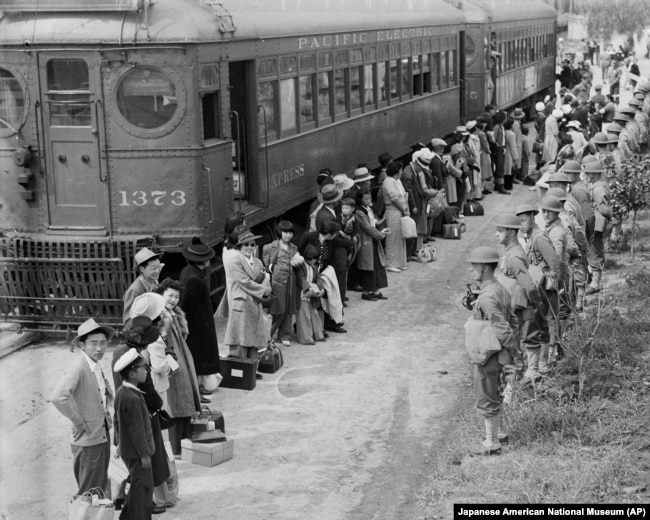
파일 - 국립문서보관소가 제공한 이 사진에서 1942년 4월 5일 캘리포니아주 아카디아에 있는 산타 아니타 조립 센터에 도착한 캘리포니아주 샌 페드로 출신의 일본계 미국인들.
FILE - In this photo provided by the National Archives, Japanese Americans from San Pedro, Calif., arrive at the Santa Anita Assembly Center in Arcadia, California, April 5, 1942.
이레이 프로젝트는 사망한 피수용자들의 영혼을 추모하고 위로하기 위해 캘리포니아 만자나르와 콜로라도 아마체의 수용소에 수감된 사람들에 의해 지어진 이레이토라고 불리는 석불 기념물에서 영감을 얻었습니다.
The Irei project was inspired by stone Buddhist monuments called Ireitōs that were built by detainees at camps in Manzanar, California, and Amache, Colorado, to memorialize and console the spirits of internees who died.
이레이 기념비의 첫 번째 부분은 125,284명의 일본계 미국인 억류자들의 확인된 이름들을 나열한 성서인 이레이초입니다.
The first part of the Irei monument is the Ireichō, the sacred book listing 125,284 verified names of Japanese American detainees.
"우리는 이 모든 사람들에게 존엄성과 인격, 개성을 되돌려줘야 한다고 느꼈습니다," 라고 윌리엄스가 말했습니다. "우리가 그렇게 할 수 있다고 생각한 가장 좋은 방법은 그들에게 그들의 이름을 돌려주는 것이었습니다."
“We felt like we needed to bring dignity and personhood and individuality back to all these people," Williams said. "The best way we thought we could do that was to give them their names back.”
두 번째 요소인 '이레이조'는 방문객들이 수감자들에 대한 추가적인 정보를 찾기 위해 사용할 수 있는 추모의 날인 월요일에 시작될 예정인 웹사이트입니다. '이레이조'는 마지막 부분입니다: 수감 장소들과 일본계 미국인 국립 박물관에 설치된 조명들의 모음입니다.
The second element, the Ireizō, is a website set to launch on Monday, the Day of Remembrance, which visitors can use to search for additional information about detainees. Ireihi is the final part: A collection of light installations at incarceration sites and the Japanese American National Museum.
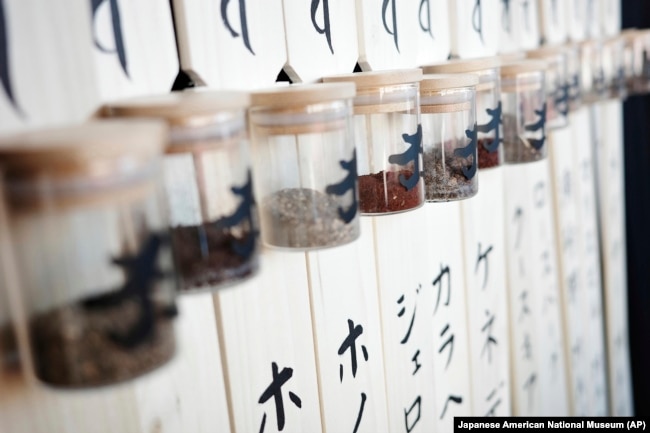
파일 - 일본계 미국인 국립 박물관이 제공한 이 사진에는 제2차 세계 대전 당시 일본계 미국인 수용소 75곳의 흙이 9월 로스앤젤레스 박물관에 전시되어 있습니다
FILE - In this photo provided by the Japanese American National Museum, soil from the seventy-five internment camps for Japanese Americans in World War II, is displayed at the museum in Los Angeles, Sept. 24, 2022.
윌리엄스와 그의 팀은 3년 이상을 수용소 생존자들과 그들의 친척들에게 연락하여 철자가 틀린 이름과 데이터 오류를 수정하고 부족한 부분을 메웠습니다. 그들은 수감자 이송 기록 보관소에 있는 기록들과 수감자들이 만든 적 외계인 신분증 및 명부들을 분석했습니다.
Williams and his team spent more than three years reaching out to camp survivors and their relatives, correcting misspelled names and data errors and filling in the gaps. They analyzed records in the National Archives of detainee transfers, as well as Enemy Alien identification cards and directories created by detainees.
우리는 우리가 그 목록에 대해 적어도 99% 정확하다고 꽤 확신합니다."라고 Williams는 말했습니다.
“We feel fairly confident that we’re at least 99% accurate with that list,” Williams said.
이 팀은 캠프에 입소한 가장 나이가 많은 사람부터 그곳에서 태어난 마지막 아기까지 모든 이름을 나이순으로 기록했습니다.
The team recorded every name in order of age, from the oldest person who entered the camps to the last baby born there.
불교 사제인 윌리엄스는 이레초를 박물관에 소개하는 기념식에 참석하기 위해 다양한 종교, 아메리카 원주민 부족 및 사회 정의 단체의 지도자들을 초대했습니다.
Williams, who is a Buddhist priest, invited leaders from different faiths, Native American tribes and social justice groups to attend a ceremony introducing the Ireichō to the museum.
수용소 생존자들과 수감자들의 후손들이 수용소 각각의 이름이 새겨진 소바타라고 불리는 나무 기둥들을 하나씩 들고 수용소에 들어가는 것을 보기 위해 사람들이 리틀 도쿄 인근에 모였습니다. 행렬이 끝날 무렵, 이 크고 무거운 이름의 책은 여러 명의 종교 지도자들에 의해 안으로 옮겨졌습니다. 윌리엄스는 불교 경전을 읽고 수감자들을 기리기 위한 구호를 외쳤습니다.
Crowds of people gathered in the Little Tokyo neighborhood to watch camp survivors and descendants of detainees file into the museum, one by one, holding wooden pillars, called sobata, bearing the names of each of the camps. At the end of the procession, the massive, weighty book of names was carried inside by multiple faith leaders. Williams read Buddhist scripture and led chants to honor the detainees.

파일 - 국가기록원이 제공한 이 사진에서 미국 군단원과 보이 스카우트를 포함한 일본계 미국인들이 5월 캘리포니아주 만자나르에 있는 수용소인 만자나르 이주 센터에서 현충일 예배에 참여하고 있습니다
FILE - In this photo provided by the National Archives, Japanese Americans, including American Legion members and Boy Scouts, participate in Memorial Day services at the Manzanar Relocation Center, an internment camp in Manzanar, Calif., May 31, 1942.
그 소바타들은 이제 이레초가 12월 1일까지 남아있을 고요한 울타리의 벽들을 따라 늘어져 있습니다. 각각은 - 영어와 일본어로 - 그것이 나타내는 수용소의 이름을 가지고 있습니다. 각각의 기둥에 매달린 것은 그 이름이 붙여진 장소의 흙을 담고 있는 항아리입니다.
Those sobata now line the walls of the serene enclosure where the Ireichō will remain until Dec. 1. Each bears the name — in English and Japanese — of the camp it represents. Suspended from each post is a jar containing soil from the named site.
방문객들은 이레초에서 사랑하는 사람들을 찾고 그들의 이름에 한코라고 불리는 일본 우표를 사용하여 표시를 남기도록 권장됩니다.
Visitors are encouraged to look for their loved ones in the Ireichō and leave a mark under their names using a Japanese stamp called a hanko.
가장 먼저 도장을 찍은 사람들은 생존한 마지막 수용소 수감자들 중 일부였습니다.
The first people to stamp it were some of the last surviving camp detainees.
지금까지 40,000명의 방문객들이 그들의 명성을 떨쳤습니다. Williams에게, 그 상호작용은 필수적입니다.
So far, 40,000 visitors have made their mark. For Williams, that interaction is essential.
"책에 도장을 찍어 한 사람 한 사람을 기린다는 것은 여러분이 매일 기념비를 바꾸고 있다는 것을 의미합니다," 라고 윌리엄스가 말했습니다.
“To honor each person by placing a stamp in the book means that you are changing the monument every day,” Williams said.

파일 - Japan American National Museum에서 제공한 이 사진에서 Barbara Keimi는 2022년 9월 24일 로스앤젤레스에 있는 Japan American National Museum에서 Ireicho에 도장을 찍습니다. T
FILE - In this photo provided by the Japanese American National Museum, Barbara Keimi stamps the Ireichō at the Japanese American National Museum in Los Angeles, Sept. 24, 2022. T
캠프 아마체에 수감된 부모와 남편을 기념하기 위해 이레이초를 방문한 샤론 마츠우라 씨는 이 기념비가 특히 미국의 이 가혹한 이야기의 장에 대해 모를 수도 있는 젊은이들에게 경각심을 일깨우는 데 중요한 역할을 하고 있다고 말합니다.
Sharon Matsuura, who visited the Ireichō to commemorate her parents and husband who were incarcerated in Camp Amache, says the monument has an important role to play in raising awareness, especially for young people who may not know about this harsh chapter in America's story.
"젊은 남녀들이 나라를 위해 싸우고 죽을 만큼 충분히 좋은 사람들이었지만, 그들은 끔찍한 환경과 캠프에서 살아야 했습니다"라고 마쓰우라는 말합니다. "우리는 사람들이 이런 일들이 일어났다는 것을 깨닫기를 바랍니다."
“It was a very shameful part of history that the young men and women were good enough to fight and die for the country, but they had to live in terrible conditions and camps," Matsuura says. "We want people to realize these things happened.”
많은 생존자들이 자신들이 견뎌낸 것에 대해 침묵을 지키고 있으며, 그것을 다시 체험하고 싶어하지 않는다고 마츠우라 씨는 말합니다.
Many survivors remain silent about what they endured, not wanting to relive it, Matsuura says.
피네도는 그녀의 할머니 베르니스 요시 피네도가 그녀의 아버지의 이름 아래 파란색 점에 조심스럽게 도장을 찍는 것을 지켜봅니다. 가족들은 침묵 속에 멈춰 서서 벽에 있는 흙 항아리에서 노란 빛이 그림자를 드리우고 있습니다.
Pinedo watches as her grandmother, Bernice Yoshi Pinedo, carefully stamps a blue dot beneath her father's name. The family stands back in silence, taking in the moment, yellow light casting shadows from the jars of soil on the walls.
카네오 사카타니는 캘리포니아 최북단 툴레 호수에 구금되었을 때 겨우 14살이었습니다.
Kaneo Sakatani was only 14 when he was detained in Tule Lake, in far northern California.
"슬픕니다,"라고 버니스는 말합니다. "하지만 저는 부모님의 이름이 거기에 있다는 것이 매우 자랑스럽습니다."
“It’s sad,” Bernice says. “But I feel very proud that my parents’ names were in there.”
출처 : VOANews
댓글목록 0
등록된 댓글이 없습니다.




